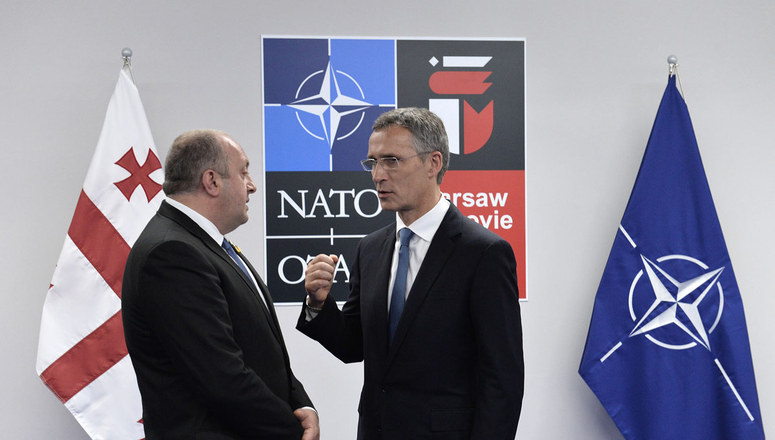
NATO-Georgia: The Open Door Policy’s Failing Test (Part One)
Publication: Eurasia Daily Monitor Volume: 13 Issue: 136
By:

It was a summit of modest expectations and modest results for the North Atlantic Treaty Organization (NATO) in Warsaw on July 8–9. These results are of an interim nature: building-blocks for further decisions at upcoming ministerial meetings, not waiting until next summit. The Warsaw results do not, as yet, correlate with the growth in Russia’s capacity to threaten, intimidate, or subvert the Alliance generally and its eastern—now “frontline”—member countries in particular.
NATO’s summit in Warsaw declared: “We reaffirm our commitment to the Open Door Policy, one of the Alliance’s great successes” (Nato.int, July 9, para. 110). “At the 2008 Bucharest Summit, Allies agreed that Georgia will become a member of NATO, with a Membership Action Plan as an integral part of the process. Today we reaffirm all elements of that decision, as well as subsequent decisions.” The NATO-Georgia Commission, meeting during the summit at the foreign ministers’ level, used identical language (Nato.int, July 9, para. 111).
Eight years after the April 2008 Bucharest decision, however, the Warsaw Summit gave Georgia neither an invitation to accession negotiations, nor a timeframe for implementing the Bucharest decision, nor even a Membership Action Plan (MAP) that would, in time, prepare Georgia to receive an invitation to join NATO.
The Warsaw Summit’s communiqué, and the NATO-Georgia Commission meeting during the summit, did fully acknowledge Georgia’s long-standing contributions to NATO-led operations, past and ongoing. The Summit and the Commission welcomed Georgia’s advances in preparing for eventual membership using NATO’s existing instruments. “Georgia is doing its part in allocating significant resources to this effort,” the Summit and the Commission both ascertained. These acknowledgements could have been much more convincing had they not been relegated to an even lower place in the final communiqué than had been the case at previous NATO summits: Georgia’s efforts are recorded in paragraphs 111 and 112, out of 139 paragraphs this time.
For all the acknowledgments, the corresponding political decisions to allow Georgia through the “open door,” or at least to straddle the threshold, were not made in Warsaw and do not seem likely to be made any time soon. Georgia has long had a strong footprint in NATO’s out-of-area operations, but does not have a foot in NATO’s open door.
NATO has, in the last few years, accepted or invited countries with far lesser credentials than Georgia to join the Alliance. The accessions of Albania and Croatia (both in 2009), Montenegro (officially invited by the Warsaw Summit to join the Alliance), and Macedonia (with a standing invitation to begin accession negotiations), undoubtedly are historic achievements of these countries, and net gains for NATO.
In Warsaw, the Georgian delegation welcomed Montenegro’s imminent accession as a “demonstration of NATO’s commitment to the Open Door Policy” (Civil Georgia, July 9). Undoubtedly, Georgia would be a more convincing case for a merit-based open-door policy. But NATO is not providing that demonstration in the case of Georgia. This country is undeniably the most deserving among the aspirant countries knocking at NATO’s open door for the last decade. Yet Georgia is left outside, always at the end of the queue, each time overtaken by other, less meritorious applicants.
Georgia contributes troops to NATO-led operations in Afghanistan continuously since 2005. On a per capita basis, Georgia is the single largest troop contributor among all countries involved in NATO’s Afghanistan operations. Georgia deployed 1,560 soldiers with the International Security Assistance Force (ISAF), and currently 860 with the Resolute Support Mission (the ISAF transitioned into the far smaller RSM in 2014). In absolute numerical terms, Georgia’s 860-strong contingent is the third largest in RSM, just behind Germany’s 980-strong contingent from a population twenty times larger than Georgia’s. The Georgians fought in ISAF’s most dangerous zone, Helmand, without restrictions on combat missions (“national caveats”), incurring 31 killed and almost 500 wounded (from the estimated total of 10,000 Georgian troops that served in Afghanistan over time).
It is not without irony that Germany, which had led the opposition to Georgia’s NATO MAP, contributed incomparably fewer troops on a per capita basis, deployed them to the relatively safer Kunduz, introduced multiple national caveats nonetheless, and incurred incomparably fewer combat casualties than Georgia. Such discrepancies stemmed from differing priorities: Germany doubted the validity of NATO’s Afghanistan intervention as conceived and conducted, while Georgia regarded ISAF and now RSM as opportunities to validate its own credentials as a NATO aspirant and partner of the United States.
Georgia had also contributed 2,200 troops to the US-led operation in Iraq until 2008 (not a NATO, but a coalition-of-the-willing operation), as well as several hundred troops to NATO-led peacekeeping operations in the Balkans. It has also pledged one infantry company to the evolving NATO Response Force (NRF) potentially for operations under Article Five.



